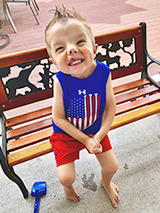Severe Infantile Scoliosis and Rib Fusion: Jonathen’s Story
Severe Infantile Scoliosis and Rib Fusion: Jonathen’s Story
Jonathen is a bright 3-year-old boy who can run and play and ride a bike — accomplishments his family could only dream of him having just a few short years ago.

Jonathen was born with a 90-degree curvature of the spine — severe infantile scoliosis — and multiple birth defects, including a cleft lip and nose, clubbed feet, syndactyly in his left hand, fused ribs, and spina bifida occulta without spinal cord tethering.
A string of surgeries would correct many of his birth defects, including two facial surgeries and hand and dental surgeries. But his severe scoliosis was the greater problem. The curvature caused thoracic insufficiency syndrome (TIS), which made breathing difficult for Jonathen and limited the ability of his lungs to grow. And it was getting worse.
The family began a long journey of medical consultations to find treatment for Jonathen’s scoliosis. The orthopedic surgeons the family saw throughout Florida, where they live, were skeptical that anything could be done for him.
“Over and over again, we were told that Jonathen had the worst case of scoliosis and fused ribs that the physicians had ever seen, and that he would only get worse and that he would never walk,” says Jonathen’s mom, Kristi.
New hope: VEPTR surgery
When Jonathen was 10 months old, Kristi learned about VEPTR surgery from a physical therapist in Florida. She did a little research and came across the Wyss/Campbell Center for Thoracic Insufficiency Syndrome at Children’s Hospital of Philadelphia (CHOP).
VEPTR is an acronym for vertical expandable prosthetic titanium rib. The VEPTR is an expandable metal rod that is surgically attached to a child’s ribs, spine or pelvis to straighten the spine, help them breathe, and correct the curvature over time. The device can be lengthened in subsequent surgeries as the child grows.
Robert Campbell, MD, who passed away on July 29, 2018, designed and pioneered the VEPTR device and surgery, and created and led the Wyss/Campbell Center for Thoracic Insufficiency Syndrome at CHOP. VEPTR became the first expandable rib in the world, and is a device that provides hope to critically ill patients who haven’t had treatment options available to them in the past.
“I remember Dr. Campbell quietly walking into the consultation room, hanging up my son’s X-rays, and confidently saying, ‘We can fix this,'” recalls Kristi. “I cried instantly, because Dr. Campbell finally gave us hope.”
By the time of his first VEPTR surgery at age 1, Jonathen’s curvature had increased to 109 degrees. He had three VEPTR devices implanted in that procedure. After surgery, his spine was corrected to a 50-degree curve, and he grew three inches. Dr. Campbell described it as a “breathe easy surgery” to Jonathen’s parents. It allowed the chest cavity to expand and essentially make breathing easier for Jonathen.
Long-term care after VEPTR surgery
Jonathen and his parents will travel to CHOP from Florida every four to six months for many years for follow-up visits to assess when to schedule surgery to either lengthen or replace the VEPTR rods as he grows. The family will continue this schedule until he reaches maturity. When he is fully grown, the rods will be removed and spinal fusion surgery will be performed to permanently correct the curvature.
“Although these surgeries are invasive, I’m forever grateful,” says Kristi. “Finding Children’s Hospital of Philadelphia and the entire Orthopedic Center at CHOP was surely an answered prayer.”
Kristi is a registered nurse, and Jonathen’s dad is a fireman in the United States Air Force. Frequent visits to CHOP are a logistical challenge. But they have a strong support network of family and friends and are more than confident in Jonathen’s care, which has been transitioned to Dr. Patrick Cahill, attending surgeon in CHOP’s Orthopedic Center, and his nurse Susanne Manzoni, BSN, RN.
“I’ve been a nurse for a long time,” says Kristi. “Susanne Manzoni is absolutely amazing. More specifically, her coordination, communication and consistency is outstanding. You really don’t have to ask many questions. She is thorough, reliable and always on top of all concerns. She is easy to approach, and she is happy to help any time of the day. The organization that CHOP has, as opposed to some other children’s hospitals — there is just no place like it. Things that are accomplished in a five-minute phone call or follow-up question at CHOP would have taken weeks from other pediatric healthcare facilities and professionals.”
A strong spirit in a growing boy

Jonathen is a bright, curious boy who is learning to read and write, and he speaks in full sentences. As his mom explains, there has never been baby talk with him. He even knows the names of all his doctors in Florida and at CHOP, just like he knows all of his favorite super hero characters.
Jonathen is currently off oxygen during the day and uses a BiPaP machine to support his breathing at night as part of his treatment for TIS.
His mom credits Howard Panitch, MD, attending pulmonologist at CHOP, with getting Jonathen comfortable wearing the BiPaP device. It’s allowed Jonathen to breathe better, and he’s finally gaining weight and, of course, growing stronger.
“Children’s Hospital of Philadelphia has certainly saved Jonathen’s life, and has truly improved his quality of life,” says Kristi. “I’m truly thankful to God for leading us to CHOP, and thankful for CHOP’s continuous advancement of medicine, top quality medical care, communication, dedication, and the impact that they continue to make in our lives.”